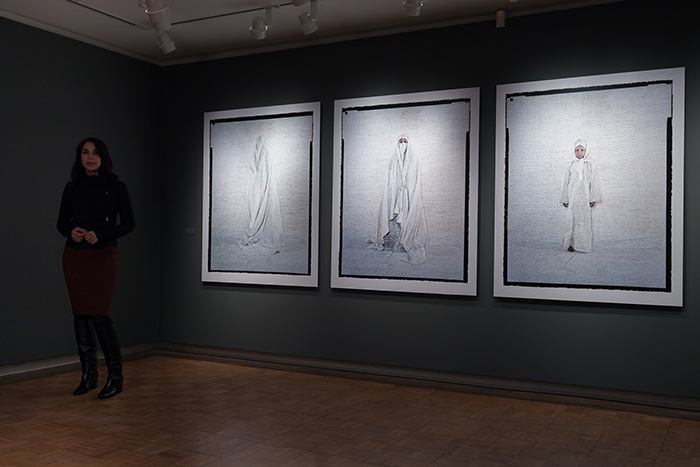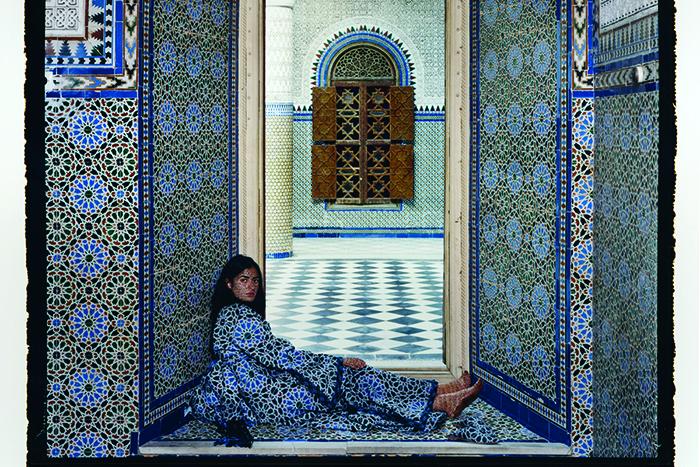Images of Islamic Women Unveiled in Essaydi Exhibition

Artist Lalla Essaydi poses in front of her work in The Trout Gallery. Photo by Carl Socolow '77.
Noted artist delivers lecture about her work
by MaryAlice Bitts-Jackson
As an Islamic woman and artist who’s lived in Morocco, Saudi Arabia, Europe and the United States, Lalla Essaydi views the world through a kaleidoscopic lens, one informed by centuries of global cultural and art history. She recently explained her view and the cross-cultural artwork it informs during a lecture on campus that kicked off an exhibition of her work in Dickinson College's Trout Gallery.
Complex identities
Essaydi grew up in Morocco, raised her family in Saudi Arabia and relocated first to France, where she studied at Ecole nationale superieure des Beaux-Arts in Paris, and then in the U.S., earning a B.F.A. from Tufts University and an M.F.A. from School of the Museum of Fine Arts, Boston. Her paintings, mixed media work, photography and videos have been exhibited around the world, and they are included in collections of the National Gallery of Art and Musee du Louvre, Paris, among others.
Each work explores the image of women in Islamic society, in both private and public spaces and across cultural contexts.
Painstaking process
The Trout Gallery is currently exhibiting portraits by Essaydi, captured on film and developed in the darkroom that she made in her now-abandoned childhood home in Morocco, where she grew up in a harem. These include Harem #14C (below), purchased with funds from the Friends of the Trout Gallery, in which the subject seems to become one with her surroundings, as the floor and walls are decorated with the same geometric pattern as her dress.
The backdrops and clothing were painstakingly hand-painted by Essaydi, who also wrote in Arabic script on her subjects’ faces—referencing calligraphy, an art form available only to males in Islamic culture, and henna, a medium for females. The text tells stories about her life, and about the lives of her subjects, who are family members and acquaintances, and comments on Eastern and Western views of Islamic women as well as the women's lived experiences.

Lalla Essaydi, Harem 14c (detail), 2009, chromogenic print.
“It's about freeing ourselves from imposed identities and seeing ourselves with our own eyes,” Essaydi explained, speaking to a standing-room-only audience in Rubendall Recital Hall during a March 1 lecture underwritten by Jane L. and Robert H. Weiner and sponsored by the Department of Art & Art History.
Photographs from Essaydi’s Bullets and Bullets Revisited series, also in the exhibition, also tackle this theme and speak to issues of violence against women as well as the East-West polarizations heightened by violence and the Western fear of terrorism. The subjects wear chain-mail-like clothing and throws that Essaydi crafted out of bullet casings. One of the garments, she said, took one year to create, working eight hours each day.
“The subject matter is interesting and relevant to what’s going on,” says Abaigeal Cottle ’20, a double major in archaeology and religion, noting that, in the wake of the Arab Spring, Essaydi first used bullet casings from along the Moroccan-Algerian border before purchasing them from the United States.
Immersive experiences
As a Trout Gallery education intern, Cottle researched, wrote and recorded the audio guide for the exhibition, in partnership with Katie Sullivan ’18 (educational studies, Spanish), and had a chance to meet with Essaydi before the lecture and also for a small-group discussion. She says her decision to attend Dickinson was heavily influenced by the chance for students to take part in intensive experiences like this.
"I was a little star-struck the first time I met her," she said with a smile, “but she was incredibly personable, gracious and articulate, and answered all of our questions with such interest and thought. That was really an incredible experience, and a unique opportunity that wouldn't be possible for an undergrad at a larger school."
TAKE THE NEXT STEPS
Published March 6, 2018